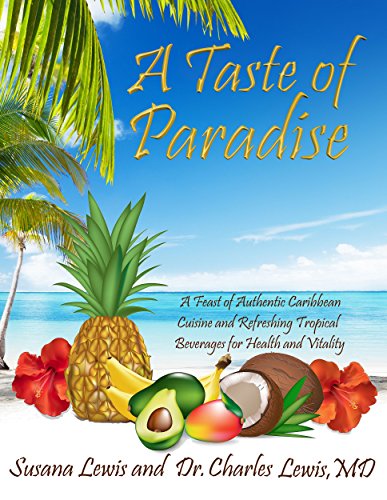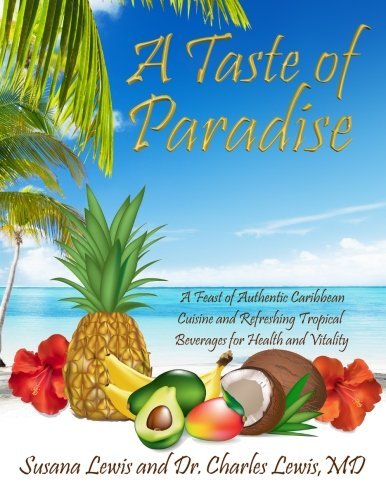-
A Taste of Paradise: A Feast of Authentic Caribbean Cuisine and Refreshing Tropical Beverages for Health and Vitality
Charles Lewis, Susana Lewis
eBook (Psy Press, Aug. 16, 2015)A Taste of Paradise is a guide to the preparation of delicious, easy to prepare foods with rich and authentic Caribbean flavors. These traditional foods form a natural, healthful diet with meals that are highly flavored and satisfying, and served with fresh cut fruit. The book provides well over 200 traditional recipes for great tasting foods, many prepared with coconut cream. This book is more than a collection of traditional Caribbean dishes. Not only does it explain how to prepare dishes, it teaches the selection and storage of tropical fruit, how to prepare plantains and cassava for cooking and how to obtain the most health benefit from foods. For example, it gives secrets on how to cook beans that are smooth and creamy and which avoid the formation of excess intestinal gas.This book was co-authored by a medical doctor board certified in preventive medicine. A section is dedicated to healthy weight loss (never calorie counting) while enjoying food. Along with the recipes are notes explaining why mangoes can cause allergic reactions in individuals susceptible to poison oak and how to avoid the reaction while enjoying the fruit, why some smoothies get bitter and how to prevent it, which tropical foods are likely to trigger migraines, which foods can be toxic if not correctly prepared. It provides instructions for safe preparation of ceviche, meats and seafoods. The section on meats explains how to prepare juicy, tender meat and how avoid creation of carcinogens during cooking. In the section on vegetables, it shows how to prepare vegetables to maximize anti-carcinogenic compounds. Most of the recipes are gluten free, and to extend this benefit, instructions are given for preparation of gluten free pastas. Many recipes use coconut rather than milk, and thus are lactose free; there are milk free recipes for flan, cake and smoothies made using coconut cream. There is even a traditional a recipe for molasses “brownies” made without milk, eggs or chocolate.The Spanish speaking Caribbean islands (Cuba, Dominican Republic, and Puerto Rico) share, climate, language, geography, and not surprisingly many elements of traditional cuisine. Many traditional dishes from the islands originated with the native residents, the Taíno people, these include corn breads, roasted turkey and root beer. Other recipes are traced back to Moorish casserole, fufu and elephant ear soup from Africa, bread and war paint used by the Arawak Indians, and spicy hot coco drink from the Aztecs. Early in their history, these islands were the crossroads for the development of the Americas, and this is reflected in the diversity of their tropical cuisine.This book gives traditional recipes, including holiday fare and provides shortcuts and modern adaptations so that the authentic flavors can be enjoyed using ingredients found in most American and Canadian cities. The authors also include recipes for the “fast foods” sold by street vendors on the islands. The book is nicely illustrated.
-
The New Revelation
Sir Arthur Conan Doyle
(Psychic Press, Jan. 1, 1938)None
-
A Taste of Paradise: A Feast of Authentic Caribbean Cuisine and Refreshing Tropical Beverages for Health and Vitality
Susana J Lewis, Charles A Lewis
Paperback (Psy Press, March 24, 2012)A Taste of Paradise is a guide to the preparation of delicious, easy to prepare foods with rich and authentic Caribbean flavors. These traditional foods form a natural, healthful diet with meals that are highly flavored and satisfying, and served with fresh cut fruit. The book provides well over 200 traditional recipes for great tasting foods, many prepared with coconut cream. This book is more than a collection of traditional Caribbean dishes. Not only does it explain how to prepare dishes, it teaches the selection and storage of tropical fruit, how to prepare plantains and cassava for cooking and how to obtain the most health benefit from foods. For example, it gives secrets on how to cook beans that are smooth and creamy and which avoid the formation of excess intestinal gas. This book was co-authored by a medical doctor board certified in preventive medicine. A section is dedicated to healthy weight loss (never calorie counting) while enjoying food. Along with the recipes are notes explaining why mangoes can cause allergic reactions in individuals susceptible to poison oak and how to avoid the reaction while enjoying the fruit, why some smoothies get bitter and how to prevent it, which tropical foods are likely to trigger migraines, which foods can be toxic if not correctly prepared. It provides instructions for safe preparation of ceviche, meats and seafoods. The section on meats explains how to prepare juicy, tender meat and how avoid creation of carcinogens during cooking. In the section on vegetables, it shows how to prepare vegetables to maximize anti-carcinogenic compounds. Most of the recipes are gluten free, and to extend this benefit, instructions are given for preparation of gluten free pastas. Many recipes use coconut rather than milk, and thus are lactose free; there are milk free recipes for flan, cake and smoothies made using coconut cream. There is even a traditional a recipe for molasses “brownies” made without milk, eggs or chocolate. The Spanish speaking Caribbean islands (Cuba, Dominican Republic, and Puerto Rico) share, climate, language, geography, and not surprisingly many elements of traditional cuisine. Many traditional dishes from the islands originated with the native residents, the Taíno people, these include corn breads, roasted turkey and root beer. Other recipes are traced back to Moorish casserole, fufu and elephant ear soup from Africa, bread and war paint used by the Arawak Indians, and spicy hot coco drink from the Aztecs. Early in their history, these islands were the crossroads for the development of the Americas, and this is reflected in the diversity of their tropical cuisine. This book gives traditional recipes, including holiday fare and provides shortcuts and modern adaptations so that the authentic flavors can be enjoyed using ingredients found in most American and Canadian cities. The authors also include recipes for the “fast foods” sold by street vendors on the islands. The book is nicely illustrated.
-
College Prep Guidebook: How to Ace High School, Excel on the SAT and ACT, and Win Admission to the College of Your Choice
Charles Lewis
eBook (Psy Press, Sept. 16, 2015)The secret to success is not working harder, but working smarter. The College Prep Guidebook provides expert mentoring advice for students encouraging the development of skills and reveals sure and easy paths that win admission to top universities and help achieve success in college. Discover proven strategies and powerful ideas that get results. Learn secrets to boosting your GPA and placement tests scores, while enjoying your high school experience. You can discover easy and proven ways to save time and help guarantee your success and happiness. This new edition of the College Prep Guidebook is updated to include recent changes in the SAT Test. This book explains the best sources of funding for a student’s education, and those that are best avoided to save money and avoid debt and burdensome obligations. It reveals how lower income students can have the ACT, SAT, and college applications fees waived. It shows how students can receive a “free ride,” full tuition, meals and housing at the most prestigious and exclusive universities, and when it may be less costly to attend a private college than a public one. This book helps high school students avoid ineffective routes, filled with drudgery and wasted effort, and reveals surer paths that facilitate the achievement their educational goals. It provides a guide, mapping out safer routes to success so students can thrive and delight in the educational experience. Among of the secrets provided are: • How to study more efficiently, learning more while expending less time and effort. • Which test (the SAT or ACT) students depending on their personal strengths and background, should focus on for the best results. • Placement test tips and strategies, and traps and pitfalls to avoid. • Strategies for achieving superior placement test scores. • How to earn a higher grade point average with minimal extra work. • How to develop the leadership experience that top colleges recruit. • How to create college applications that get the desired results. • How to compose an outstanding college application essay. • How you can, even with the same GPA and placement scores, dramatically multiply your chances gaining acceptance into premiere university. • How students from middle and low-income families can get their college education paid for at private universities. • How to gain the education benefits of an Ivy League college education from a public university. • Advice on the best and worst ways for military service to pay for college. • Advice on which sports scholarships are most advantageous. • Advice on selecting among colleges, which will serve the student best. • Mentoring on how to avoid common pitfalls that doom many college students. • How to succeed and have fun at the same time. The College Prep Guidebook provides exclusive access to bonus internet materials the including college placement practice tests, and links for applying for college and financial aid.
-
Carver of Tuskegee
Ethel Edwards
Hardcover (The Psyche Press, March 15, 1971)None
-
A Taste of Paradise: A Feast of Authentic Caribbean Cuisine and Refreshing Tropical Beverages for Health and Vitality by Susana J Lewis
Susana J Lewis;Charles A Lewis
Paperback (Psy Press, March 15, 1750)None